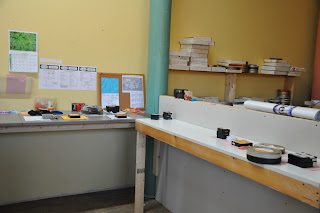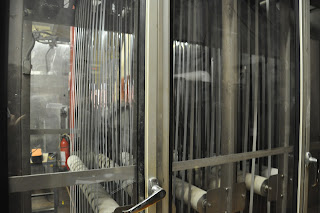Last Tuesday I saw Leighton Pierce talk at the Alfond
auditorium. He showed some of his pieces and gave a good talk. He has worked on
16 mm and also digitally. His images were not particularly impressive or
memorable for my liking but I was interested in the concepts he was playing
with, what he’s thinking about, and how and where he sources his inspiration. The
photography was abstract and often played with focus and perspective. He showed
films titled Glass, Wood, 50 Feet of String and Backsteps.
Leighton talked about being inspired by jazz and electronic music and that
music was actually his segue into film. His interest in sound is relevant in
his film making process, as in editing he selects shots that have a rich sound
potential. Even when he shoots video where sound is captured simultaneously to
imagery he will mute the sound so he can give his mind freedom to consider the
sound that will create an interesting and dynamic relationship to the visuals.
Something he said that stuck with me is “the best thing that can fill space is
sound”.
Conceptually, Pierce is interested in the mind-body fusion
and exploring the gap between mind and body. He is curious about the idea that
one can never just be looking or just be feeling. The two exist in conjunction
with, and reactively to, one another. He says that he doesn’t have a specific
strategy to separate the two but that this is what he is thinking about and
what he is attempting in his filmmaking. He attempts to mess with the way the
viewer sees the world. He considers in his shooting what is moving and what is
stationary. Why does the ball move and the people do not? For instance. He
wants the spectator to question whether what they are seeing is a dream or
reality. He spoke about how vision and sounds become a metaphor for reality and
that the form is the content. He uses sound to help create
this tension and confusion. In his film Backsteps,
for example, he uses isolated sounds that fit with the imagery but layers
the audio in a different way than we would hear them in “real life”. He talked
about being directly inspired by Steve Reich’s song ‘Come Out’ (which he also
claimed changed his life) and that he used Reich’s basic form in that song when
he was adding audio to Backsteps. In
this piece he did some stuttering and layering in which he would play the same
sound multiple times but would stutter the sound by playing them offset over
each other, each sequential clip being played just a few seconds before the
first was triggered to play. He shot the piece in a very abstract and out of
focus manner where the viewer can almost just make out the figure of two girls
in the darkness. He spoke about abstracting the world through the visual but
then in adding the girl’s voices making the world once again real to play with
this dream/ reality gray area.














































